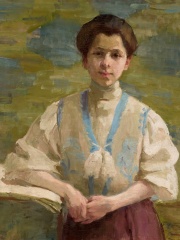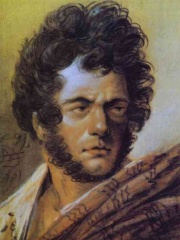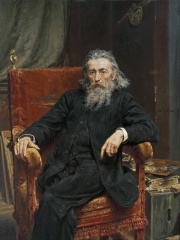
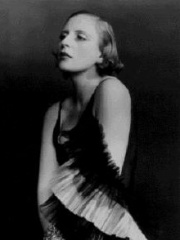
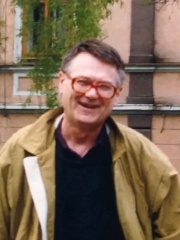
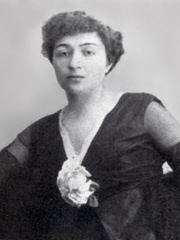
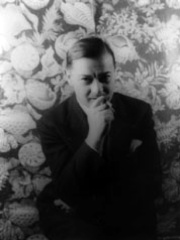
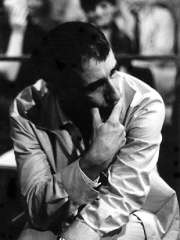
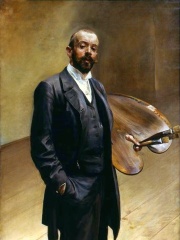
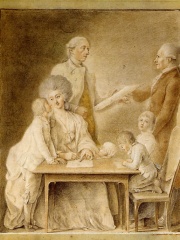
The Most Famous
PAINTERS from Poland
Top 10
The following people are considered by Pantheon to be the top 10 most legendary Polish Painters of all time. This list of famous Polish Painters is sorted by HPI (Historical Popularity Index), a metric that aggregates information on a biography's online popularity. Visit the rankings page to view the entire list of Polish Painters.

1. Jan Matejko (1838 - 1893)
With an HPI of 73.20, Jan Matejko is the most famous Polish Painter. His biography has been translated into 57 different languages on wikipedia.
Jan Alojzy Matejko (Polish pronunciation: [ˈjan aˈlɔjzɨ maˈtɛjkɔ] ; also known as Jan Mateyko; 24 June 1838 – 1 November 1893) was a Polish painter, a leading 19th-century exponent of history painting, known for depicting nodal events from Polish history. His works include large scale oil paintings such as Stańczyk (1862), Rejtan (1866), Union of Lublin (1869), Astronomer Copernicus, or Conversations with God (1873), or Battle of Grunwald (1878). He was the author of numerous portraits, a gallery of Polish monarchs in book form, and murals in St. Mary's Basilica, Kraków. He is considered by many as the most celebrated Polish painter, and sometimes as the "national painter" of Poland. Matejko spent most of his life in Kraków. He enrolled at the Kraków Academy of Fine Arts at age fourteen, where he studied under notable artists such as Wojciech Korneli Stattler and Władysław Łuszczkiewicz and completed his first major historical painting in 1853. His early exposure to revolutions in Kraków and the military service of his brothers influenced his artistic themes. After studying art in Munich and Vienna, he returned to Kraków and set up a studio. He gradually gained recognition, selling key paintings that settled his debts and created some of his most famous works, including Stańczyk and Skarga's Sermon. Matejko's art played a key role in promoting Polish history and national identity at a time when Poland was partitioned and lacked political autonomy. At the same time, Matejko's painting style has been criticised as old-fashioned and overly theatrical, labeled as "antiquarian realism". His works often lost their nuanced historical significance when displayed abroad due to the audience's unfamiliarity with Polish history. Matejko's support for the Polish cause was not just through his art; he also contributed financially and materially to the January Uprising of 1863. Later, he became director of the art academy in Kraków, which was eventually renamed the Jan Matejko Academy of Fine Arts. A number of his students became prominent artists in their own right, including Maurycy Gottlieb, Jacek Malczewski, Józef Mehoffer and Stanisław Wyspiański. He received several honors during his lifetime, including the French Légion d'honneur. Matejko was among the notable people to receive an unsolicited letter from the German philosopher Friedrich Nietzsche, as the latter tipped, in January 1889, into his psychotic breakdown while in Turin.

2. Tamara de Lempicka (1898 - 1980)
With an HPI of 73.00, Tamara de Lempicka is the 2nd most famous Polish Painter. Her biography has been translated into 48 different languages.
Tamara Łempicka (pronounced [taˈmara wɛmˈpit͡ska] ; 16 June 1894 – 18 March 1980), known outside Poland as Tamara de Lempicka, was a Polish painter who spent her working life in France and the United States. She is best known for her polished Art Deco portraits of aristocrats and the wealthy, and for her highly stylized paintings of nudes. Born in Warsaw, records have long asserted her birth name was Tamara Rozalia Gurwik-Górska, though documents have uncovered her true name as Tamara Rosa Hurwitz. She briefly moved to Saint Petersburg where she married Tadeusz Łempicki, a prominent Polish lawyer, then travelled to Paris. She studied painting with Maurice Denis and André Lhote. Her style was a blend of late, refined cubism and the neoclassical style, particularly inspired by the work of Jean-Dominique Ingres. She was an active participant in the artistic and social life of Paris between the wars. In 1928, she became the mistress of Baron Raoul Kuffner, a wealthy art collector from the former Austro-Hungarian Empire, divorcing Tadeusz Łempicki that same year. After the death of Kuffner's wife in 1933, Łempicka married Kuffner in 1934, and thereafter she became known in the press as "The Baroness with a Brush". Following the outbreak of World War II in 1939, she and her husband moved to the United States and she painted celebrity portraits, as well as still lifes and, in the 1960s, some abstract paintings. Her work was out of fashion after World War II, but made a comeback in the late 1960s, with the rediscovery of Art Deco. She moved to Mexico in 1974, where she died in 1980. At her request, her ashes were scattered over the Popocatépetl volcano.

3. Zdzisław Beksiński (1929 - 2005)
With an HPI of 71.08, Zdzisław Beksiński is the 3rd most famous Polish Painter. His biography has been translated into 35 different languages.
Zdzisław Beksiński (pronounced [ˈzd͡ʑiswaf bɛkˈɕiɲskʲi]; 24 February 1929 – 21 February 2005) was a Polish painter, photographer, and sculptor. Beksiński made his paintings and drawings in what he called either a Baroque or a Gothic manner. His creations were made mainly in two periods. The first period of work is generally considered to contain expressionistic colour, with a strong style of "utopian realism" and surreal architecture. The second period contained more abstract style, with the main features of formalism. Beksiński was stabbed to death at his Warsaw apartment on February 21, 2005, by a 19-year-old acquaintance from Wołomin, reportedly because Beksiński refused to lend him money.

4. Aleksandra Ekster (1882 - 1949)
With an HPI of 68.30, Aleksandra Ekster is the 4th most famous Polish Painter. Her biography has been translated into 38 different languages.
Aleksandra Aleksandrovna Ekster (née Grigorovich; Russian: Алекса́ндра Алекса́ндровна Эксте́р; Ukrainian: Олекса́ндра Олекса́ндрівна Е́кстер; 18 January 1882 – 17 March 1949), also known as Alexandra Exter, was a Russian and French painter and designer. As a young woman, her studio in Kiev attracted all the city's creative luminaries, and she became a figure of the Paris salons, mixing with Picasso, Braque and others. She is identified with the Russian/Ukrainian avant-garde, as a Cubo-futurist, Constructivist, and influencer of the Art Deco movement. She was the teacher of several School of Paris artists such as Abraham Mintchine, Isaac Frenkel Frenel and the film directors Grigori Kozintsev, Sergei Yutkevich among others.
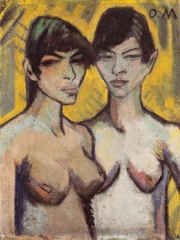
5. Otto Mueller (1874 - 1930)
With an HPI of 65.83, Otto Mueller is the 5th most famous Polish Painter. His biography has been translated into 29 different languages.
Otto Mueller (16 October 1874 – 24 September 1930) was a German painter and printmaker of the Die Brücke expressionist movement.

6. Moïse Kisling (1891 - 1953)
With an HPI of 64.92, Moïse Kisling is the 6th most famous Polish Painter. His biography has been translated into 24 different languages.
Moïse Kisling (born Mojżesz Kisling; 22 January 1891 – 29 April 1953) was a Polish-born French painter. Born in Kraków, then part of Austria-Hungary, to Jewish parents, Kisling studied at the Academy of Fine Arts. He left for Paris in 1910 at the age of 19. After moving to Montmartre, Kisling became a member of the Parisian avant-garde known also as the School of Paris, and developed close professional relationships with painters Amedeo Modigliani and Jules Pascin, among others. Kisling gained recognition for portraying the female form and completed numerous nudes and portraits during his career. He became a French national in 1924, after serving and being wounded with the French Foreign Legion in World War I. In 1940, despite being 49, Kisling rejoined the army for World War II but moved to the United States following the French Army's surrender and the impending threat to Jews in occupied France. In the U.S., he exhibited his works in New York City and Washington and settled in Southern California. After World War II and the defeat of Nazi Germany, Kisling returned to France. He lived his later years continuing his artwork until his death in 1953, after a brief illness. His works are held by museums globally, including the Harvard Art Museums, British Museum, and the Metropolitan Museum of Art, among other institutions. The Musée du Petit Palais in Geneva holds a significant collection of Kisling's paintings.

7. Tadeusz Kantor (1915 - 1990)
With an HPI of 64.22, Tadeusz Kantor is the 7th most famous Polish Painter. His biography has been translated into 25 different languages.
Tadeusz Kantor (6 April 1915 – 8 December 1990) was a Polish painter, assemblage and Happenings artist, set designer and theatre director. Kantor is renowned for his revolutionary theatrical performances in Poland and abroad. Laureate of Witkacy Prize – Critics' Circle Award (1989).

8. Jacek Malczewski (1854 - 1929)
With an HPI of 63.60, Jacek Malczewski is the 8th most famous Polish Painter. His biography has been translated into 31 different languages.
Jacek Malczewski (Polish: [ˈjat͡sɛk malˈt͡ʂɛfskʲi] ; 15 July 1854 – 8 October 1929) was a Polish symbolist painter who was one of the central figures of the patriotic Young Poland movement. His works combined the predominant style of his time with historical motifs of Polish martyrdom, the romantic aspiration for national independence, Christian and Greek mythology, folk tales, and his love of the natural world. He was the father of painter Rafał Malczewski.

9. Daniel Chodowiecki (1726 - 1801)
With an HPI of 63.38, Daniel Chodowiecki is the 9th most famous Polish Painter. His biography has been translated into 22 different languages.
Daniel Niklaus Chodowiecki (16 October 1726 – 7 February 1801) was a German painter and printmaker of Huguenot and Polish ancestry, who is most famous as an etcher. He spent most of his life in Berlin, and became the director of the Berlin Academy of Art.
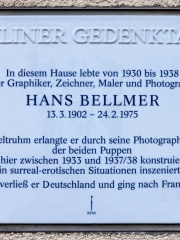
10. Hans Bellmer (1902 - 1975)
With an HPI of 63.34, Hans Bellmer is the 10th most famous Polish Painter. His biography has been translated into 20 different languages.
Hans Bellmer (13 March 1902 – 24 February 1975) was a German artist, best known for his drawings, etchings that illustrates the 1940 edition of Histoire de l’œil, and the life-sized female dolls he produced in the mid-1930s. Historians of art and photography also consider him a Surrealist photographer.
People
Pantheon has 48 people classified as Polish painters born between 1689 and 1952. Of these 48, 2 (4.17%) of them are still alive today. The most famous living Polish painters include Jacek Yerka, and Pat Blair. The most famous deceased Polish painters include Jan Matejko, Tamara de Lempicka, and Zdzisław Beksiński.
Living Polish Painters
Go to all RankingsDeceased Polish Painters
Go to all RankingsJan Matejko
1838 - 1893
HPI: 73.20
Tamara de Lempicka
1898 - 1980
HPI: 73.00
Zdzisław Beksiński
1929 - 2005
HPI: 71.08
Aleksandra Ekster
1882 - 1949
HPI: 68.30
Otto Mueller
1874 - 1930
HPI: 65.83
Moïse Kisling
1891 - 1953
HPI: 64.92
Tadeusz Kantor
1915 - 1990
HPI: 64.22
Jacek Malczewski
1854 - 1929
HPI: 63.60
Daniel Chodowiecki
1726 - 1801
HPI: 63.38
Hans Bellmer
1902 - 1975
HPI: 63.34
Olga Boznańska
1865 - 1940
HPI: 62.63
Aleksander Orłowski
1777 - 1832
HPI: 62.18
Overlapping Lives
Which Painters were alive at the same time? This visualization shows the lifespans of the 25 most globally memorable Painters since 1700.



